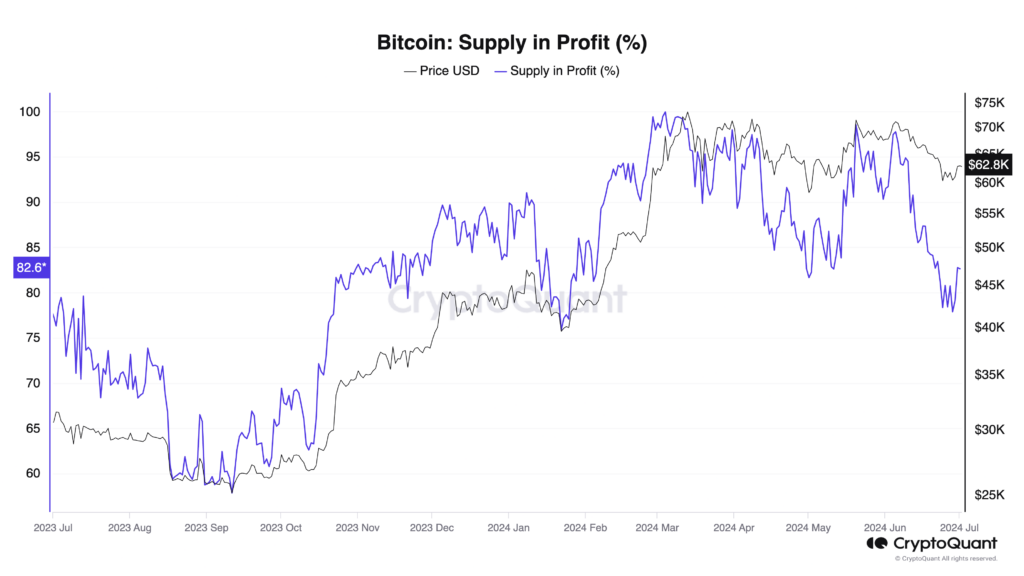
Since Bitcoin’s fourth halving on April 19th, its price action has remained sideways, in a consolidation phase. When viewed from a broader perspective, Bitcoin maintains a bullish uptrend year-to-date. This uptrend has been significantly driven by the approval of several U.S. Bitcoin Spot ETFs and subsequent institutional inflows in the following months.
Despite the ongoing narrative of a bull market, recent dips in Bitcoin’s price have introduced a degree of apathy and fear among investors. This report aims to analyze Bitcoin’s current state and its potential trajectory in the coming months by examining key on-chain indicators and macroeconomic factors that could provide insights into Bitcoin’s future direction.
As of July 1st, 2024, Bitcoin is up 48% year-to-date. However, since March, Bitcoin’s price has been consolidating and experiencing short-term dips, fluctuating within the $58,000 to $73,000 range. This period of sideways trading has brought the Crypto Fear and Greed index from a high of 90 in the first week of March 2024 to a low of 30 towards the end of June 2024.
Understanding Bitcoin’s Price Action
On 11th Jan 2024, 11 Spot Bitcoin ETFs were finally listed on US Exchanges after a decade-long legal tussle between the SEC and large financial institutions like Grayscale, Blackrock, Fidelity etc. This event solidified Bitcoin as an institutional asset class while making it far more accessible to non-crypto natives. After a brief correction, the massive ETF inflows and optimism in the markets drove Bitcoin prices to the moon, rallying from a low of $38,555 by around 86%, claiming a new high of $73,777 on 14th March, 2024.
BTC then underwent its 4th Halving Event on 20th April, 2024 which reduced the mining rewards from 6.25 BTC per block to 3.125 BTC per block mined. This landmark event has historically been associated with bullish moves and the start of bull runs in the market cycle of BTC. However, if we compare the current cycle with previous halving events, it is evident that Bitcoin has experienced a premature or accelerated bull run, breaching all-time highs before halving for the first time.
On the contrary, after reaching a new peak of $73,777, Bitcoin’s price action has moved sideways with occasional dips. Following the halving, on May 1, 2024, Bitcoin reached a low of $56,552 due to the pre-FOMC (Federal Open Market Committee) meeting jitters, but it quickly regained momentum.
Later in June 2024, macroeconomic factors like ETF outflows and geopolitical tensions have created a new wave of selling pressures. The recent announcement of Mt. Gox’s plan to distribute 142,000 BTC to its creditors starting in July[1] and the German Government’s sale of around 900 BTC[2] ($54 million) from its seized collections have further fueled fear in the market.
However, despite growing skepticism, Bitcoin appears to be forming a similar re-accumulation range post-halving that we have seen in previous bull market cycles. Looking at a technical analysis of Bitcoin’s historical price movement, an ascending triangle has formed, indicating a bullish trend for BTC. Starting June 7, Bitcoin entered a correction phase, with the bearish channel persisting until June 24, when it retested the trendline of the ascending triangle, which provided strong support.
Although BTC broke below the $60,000 mark multiple times, the demand zone was robust enough, with bulls guarding key support levels, to push the price back into the ascending triangle. Currently, Bitcoin is recovering from this shake-off and is trading at $62,990 (as of July 2, 6:50 PM, IST).
Figure 1: Bitcoin’s Ascending Triangle Pattern (27 June, 2024)
Technical Indicators Signal Bitcoin’s Long-Term Bullish Trajectory
The Bull Market Support Band is a technical indicator consisting of the 20-week simple moving average (SMA) and the 21-week exponential moving average (EMA). From October 17, 2023, the BTC price has consistently remained above the Bull Market Support Band (BMSB). Notably, even at the local bottom of $56,552, Bitcoin’s price stayed above the BMSB.
On the 1-day timeframe, BTC has dipped below the Bull Market Support Band (BMSB). While this price action below the BMSB is concerning, BTC has respected the trendline support and re-entered the ascending triangle pattern, indicating a promising outlook. Interestingly, Bitcoin has retested the 200-day EMA, which aligns with the May low of $56,552. This level has thus far provided support, indicating that the short-term range low may be established. Additionally, the Relative Strength Index (RSI) appears oversold, further confirming a bullish trajectory.
On-chain Metrics indicate BTC’s Bullish Trend is Intact
82.6% of the circulating supply is now in profit, meaning that a majority of investors’ cost basis is below the current spot price. This widespread profitability indicates strong underlying bullish sentiment, suggesting that a significant portion of holders are confident in Bitcoin’s long-term potential and are less likely to sell at current price levels.

Figure 2: Bitcoin: Percent Supply in Profit[3]
Currently, the average coin holds an unrealized profit of around +120%, which is typical for markets trading near previous cycle all-time highs (ATH). Additionally, the Market Value to Realized Value[4] (MVRV) ratio remains above its yearly baseline, indicating that the macro uptrend remains intact. This metric reinforces the bullish outlook, showing that Bitcoin’s market value is well above its realized value, suggesting that long-term investors are holding strong, anticipating further price appreciation.
Overall, these on-chain metrics illustrate that Bitcoin’s bullish trend is still intact, despite recent market consolidation. The high profitability ratio and sustained MVRV ratio both point to a healthy market foundation.
Bitcoin SOPR Metrics Reveal Increased Profit Taking
The Bitcoin SOPR[5] (Spent Output Profit Ratio) has consistently remained above 1.0 since October 2023, indicating that profits are being realized. In a bull market, when the SOPR falls below 1, investors are selling at a loss and are therefore reluctant to do so. This significantly reduces supply, which in turn exerts upward pressure on the price. The transient dips in the SOPR reflect periods where investors are booking healthy profits and increasing market supply. Since Bitcoin breached $60,000 in March, profit-taking has been both high and consistent, suggesting a steady addition of supply to the market and tempering potential upward price action.
Figure 3: Bitcoin: Spent Output Profit Ratio (SOPR) (27 June, 2024)
When analyzing the metric from a short-term perspective, the SOPR has been gradually trending lower. This trend implies that highly profitable coins are not being spent, indicating that sellers are becoming exhausted. Although more time is needed for this trend to manifest fully, the SOPR for short-term holders retesting and rebounding above 1.0 could signal the end of the current correction and the beginning of a new bullish trend.
Heightened Indecision in the Market
The market is experiencing a phase of consolidation marked by reduced speculative activity and increased caution among both short-term and long-term holders. This period of indecision and lower transaction volumes could potentially pave the way for a more stable and sustainable bullish trend once the market digests the recent gains and establishes a new equilibrium.
Figure 4: Bitcoin: Post ATH Realized Profit Decline[6]
When we examine previous market cycles, typically, after reaching a new all-time high (ATH), the market requires time to consolidate and absorb the additional supply. Currently, short-term holders are sending around 17,400 BTC per day to exchanges.
This is significantly lower than the peak of 55,000 BTC per day recorded when the market reached the $73,000 ATH in March, indicating a period of excessive speculation. A similar trend is observed among long-term holders, suggesting that both groups are exhibiting more cautious behavior.
Key Levels to Watch
Bitcoin currently encounters interim resistance at $63,500-$64,000 and $68,400-$70,600. If the triangle pattern breaks out, a new all-time high is achievable, potentially pushing BTC to $80,000-$82,000.
Our analysis of the liquidation heatmap indicates an imminent short squeeze, making a rise to $85,000 plausible. In the event of a bearish reversal, we identify the immediate support zone as $56,000-$58,000. If BTC breaks down further, it could revisit the $50,500-$52,250 range.
Conclusion
In conclusion, despite the recent sideways trading and short-term dips, Bitcoin’s overarching bullish narrative remains intact. The approval of multiple Bitcoin Spot ETFs and significant institutional inflows have fortified Bitcoin’s position as a formidable asset class.
Since reaching an all-time high of $73,777 in mid-March, Bitcoin has entered a consolidation phase, fluctuating between $58,000 and $73,000. This period of sideways trading has tempered market enthusiasm, but historical patterns and current technical indicators signal a potential breakout.
Key on-chain indicators and technical patterns suggest that the recent correction has largely been due to reduced speculative activity and long term holders realizing profits. Technical analysis indicates that if Bitcoin successfully breaks out of the ascending triangle pattern, it could realistically achieve new all-time highs, with targets ranging from $85,000 to $100,000 by the end of the year.
However, the trajectory of Bitcoin prices will also be influenced by broader macroeconomic factors. The potential for the Federal Reserve to cut interest rates to curb inflation could provide a favorable environment for Bitcoin, as lower interest rates often drive investors towards alternative assets.
Additionally, the upcoming US presidential elections add another layer of complexity, with potential shifts in cryptocurrency policy. Former President Trump’s campaign promises to enhance cryptocurrency adoption and Bitcoin mining in the US could further bolster market sentiment and drive prices higher.
Overall, while the current consolidation phase has introduced some market apprehension, the long-term outlook for Bitcoin remains positive, supported by both technical and fundamental factors. If the bullish market conditions persist, Bitcoin could claim new ATHs by the end of the year. The interplay of macroeconomic developments and political shifts will be crucial in shaping Bitcoin’s future trajectory.
Disclaimer: The information and data presented in this report is not intended as financial advice. Our analysts aim to provide data with the highest accuracy and objectivity, but investors should exercise caution when making investment decisions. Cryptocurrency investments carry inherent risks, and you should conduct thorough research and consult with a professional financial advisor before proceeding.
References
- Mt. Gox to distribute $9 billion of Bitcoin, Bitcoin cash repayments from beginning of July. (n.d.). TheBlock. https://www.theblock.co/post/301448/mt-gox-to-distribute-9-billion-of-bitcoin-bitcoin-cash-repayments-from-beginning-of-july
- Vardai, Z. (2024) German gov’t offloads 900 Bitcoin, 400 BTC sent to Coinbase and Kraken, Cointelegraph. https://cointelegraph.com/news/german-gov-sells-900-bitcoin-400-btc-coinbase-kraken
- CryptoQuant – Bitcoin Supply-in-Profit Percent https://cryptoquant.com/asset/btc/chart/network-indicator/supply-in-profit-percent
- MVRV Ratio | GlassNode Academy. (n.d.). https://academy.glassnode.com/market/mvrv/mvrv-ratio
- CryptoQuant – Bitcoin Spent Output Profit Ratio (SOPR) https://cryptoquant.com/asset/btc/chart/market-indicator/spent-output-profit-ratio-sop
- GlassNode Studio – On-Chain Market Intelligence. (n.d.). https://studio.glassnode.com/workbench/dfb8bc2a-af96-4837-6121-fa6eb0cd05ed





